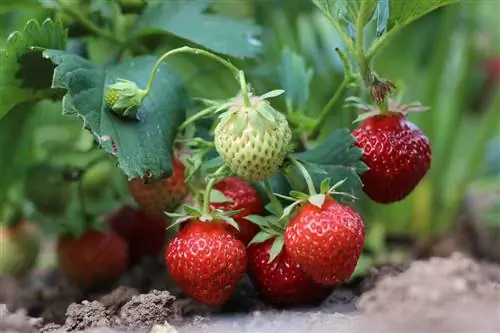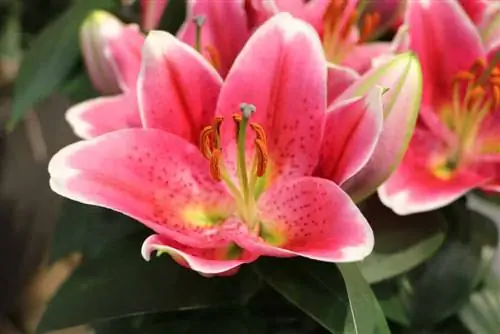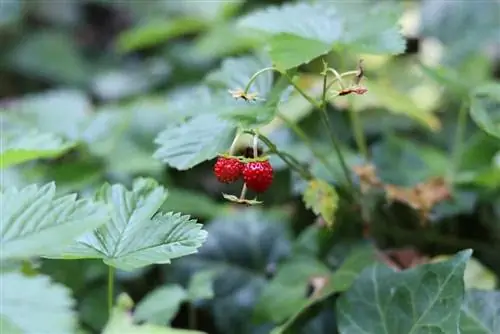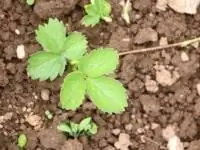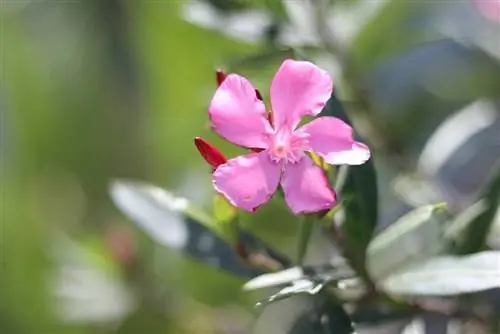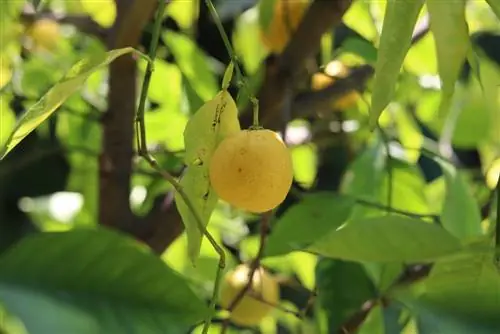- Author admin [email protected].
- Public 2023-12-17 03:39.
- Last modified 2025-01-24 12:45.
Do strawberry plants need winter protection? Where is the best place to keep the sweet fruits? Can hanging strawberries be left outside all year round? And is it possible to store wild strawberries in the cellar in winter? Many helpful tips for overwintering strawberries can be found in this guide.
Relevance of the variety
Depending on the variety, the red crops not only taste more or less intensely sweet, but also have vegetative differences. Monthly strawberries, for example, are considered very easy to care for because they hardly produce any offshoots that the gardener has to cut off before winter. Nevertheless, removing the dead leaves is also necessary for this species. The wild strawberries, which are also popular, are a relatively new variety that are considered to be particularly robust. Winter protection is nevertheless necessary.

Whether the gardener grows strawberries that bear once or always does not matter when it comes to overwintering. Almost every variety is perennial, which is why the name sounds a bit misleading. In this case, single-bearing does not mean that the plants have to be discarded after harvest, but rather that they only bear fruit once per season. What is important, however, is the time at which the respective variety produces fruit. The gardener is not allowed to cut late varieties after the harvest as they would no longer recover before the temperature drops.
Note:
Basically all strawberry varieties are perennial. However, even ever-bearing species produce fewer fruits after three years at the latest. This is completely natural and has nothing to do with improper wintering.
Relevance of location
Fragaria is a shallow-rooted plant. Since the root system runs close to the surface of the earth, the fruit plants are particularly susceptible to frost. Once the soil freezes completely, the plant dies. How extensive winter protection is required depends on the type of cultivation.
Wintering outdoors
Outdoor strawberries are exposed to sub-zero temperatures without any protection. There is a high risk of the substrate freezing, especially on loamy soils, as water quickly accumulates in winter under these conditions. The gardener can prevent his crops from dying due to cold as follows:
- After harvesting, cut back all withered plant parts
- also remove unnecessary offshoots
- under no circumstances damage the heart leaf
- loose up the soil with sand
- apply a layer of straw or mulch on the root disc
- alternatively use a breathable winter fleece
- Additionally enrich the substrate with compost
Note:
It is also possible to cover monthly strawberries with a tarpaulin. As soon as temperatures rise permanently above freezing point, self-caterers must definitely remove them again. Otherwise, as the air accumulates under the material, there is an acute risk of mold.
Overwintering in raised beds

The raised bed is a popular location for monthly strawberries. Although it offers good pest protection, in winter the earth threatens to freeze completely. To prevent this, the gardener covers the bed with Styrofoam panels. They can be fixed with wire or additional wooden pallets. After the cold phase they are removed again.
Overwintering in a pot
Although there is generally a higher risk of the substrate freezing completely when growing in containers, since this form of cultivation usually takes place on the balcony, the strawberries benefit from the protection of a house wall. The self-sufficiency owner should take into account that hanging strawberries are not exposed to cold drafts. He overwinteres his potted strawberries near the facade as follows:
- cut back after harvest
- apply a protective layer of mulch, straw, perlite, wood shavings or sawdust
- Place standing pots on a wooden plate or Styrofoam
- Line the bucket with jute or bubble wrap
Why remove the leaves?
By cutting foliage back to the ground, gardeners prevent it from robbing plants of unnecessary energy. Without above-ground growth, they can fully concentrate on their own defense against the cold. Ideally, pruning should be done promptly, around July. In October, the gardener removes new runners as necessary that have formed over the past two months. To avoid leaving any cuts, he should use sharp, sterile secateurs.
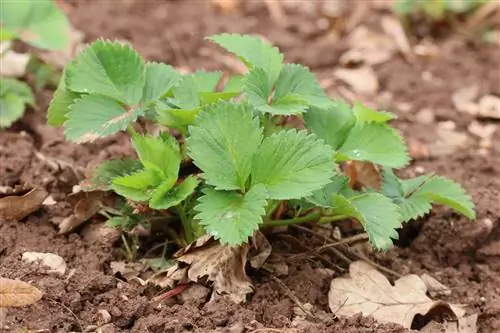
Note:
A lawn mower is also suitable for separating the above-ground growth from outdoor strawberries. Since the cuts on the stems have to dry out before the first frost, gardeners should tackle this radical method a few weeks earlier.
Nutrient intake
Although strawberries are low-eaters, adding fertilizer before winter promises a richer harvest next year. Regardless of the form of cultivation, incorporating organic material (e.g. self-made fertilizer) is sufficient.
Wintering in the cellar
Wintering in the cellar is not recommended if it can be avoided. Moving potted plants is still quite easy. Outdoor strawberries would have to be dug up and potted.
An exception are young plants that can no longer be planted in the ground in time. They must necessarily be stored in a completely frost-free place.
Note:
A self-sufficient person must plant new strawberry plants in the raised bed by the end of August at the latest so that they have enough time to get used to the new location.
Care for strawberries in winter
Despite cold temperatures, gardeners need to maintain water supplies. On frost-free days you should still water the plants. It is very important that no waterlogging occurs. This increases the risk that the plants will die if it freezes at night.
Regular pest control is also part of winter care.
Note:
Gardeners should always use new material to protect the roots. The withered leaves of the plants are not suitable as fungal spores could have embedded themselves. Dropped leaves should always be removed immediately.
How long to overwinter?
Wintering is not over with the awakening of spring. Late frosts are possible until the Ice Saints in mid-May. Gardeners often forget about the usual drop in temperature after the winter months. If the flowers freeze, the harvest will fail in summer.

